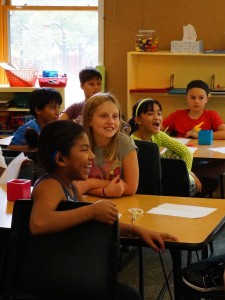Powerful Social Studies
 At Miquon, we view social studies a critical lens through which our children may practice their reading and math skills — skills that make it possible for these students to access knowledge and understanding about people, cultures, civic ideals, time, continuity, and change. Yet at the same time, we strive to ensure our program hits the mark for “powerful social studies,” as described by the National Council for the Social Studies. And, in order to be powerful, our program must be meaningful, integrative, values-based, challenging, and active in each and every classroom.
At Miquon, we view social studies a critical lens through which our children may practice their reading and math skills — skills that make it possible for these students to access knowledge and understanding about people, cultures, civic ideals, time, continuity, and change. Yet at the same time, we strive to ensure our program hits the mark for “powerful social studies,” as described by the National Council for the Social Studies. And, in order to be powerful, our program must be meaningful, integrative, values-based, challenging, and active in each and every classroom.
During the 2013-14 school year, Sarah Aghajanian and Sara Slaybaugh’s 3rd and 4th grade classroom group organized their social studies curriculum around two broad themes to achieve meaning: children’s sense of time and sense of place. With a focus on on how the Philadelphia area has changed over time, the group began their study with the landscape of early humans and moved through pre-Revolutionary colonial era. Initially investigating what the area surrounding Miquon might have looked like 500+ years ago, during the time in which the Lenape people called this area home, the children took hikes in the woods and pretended they were time travelers. Lead teacher Sarah helped the children identify what they would (and wouldn’t) see during that period of history — building a sense of place by building upon children’s familiarity and deep love of the Miquon campus, and contrasting that with verbal and visual images of pre-contact Philadelphia.
Following this, the group engaged in a read aloud of Dickon Among the Lenape. A text that is meticulously researched and historically accurate in its content (one of only two books for youngsters that The Lenape Nation currently endorses), the book further introduced children to the time period — tracing the fateful shipwreck of a boy bound for indentured servitude in Jamestown, who later finds himself taken in by a Lenape tribe in the New Jersey area.
Next the group built upon their understanding of environmental change over time through a variety of integrated, hands-on projects: constructing shelter models using natural materials, comparing their efforts to the types crafted by the Lenape (interestingly, many bore a striking resemblance); researching native plants and animals, recreating images of early Pennsylvania; and exploring the tribe’s forms of entertainment by trying out a variety of native games and activities.
Simulation, however, was the crux: The 3rd and 4th graders developed Lenape personas and wrote journal entries from the perspective of their characters, reflecting on the values those characters might have upheld at the time. Later, when the group moved into their colonial study, again the children created characters that they imbued with historical accuracy and wrote entries from these perspectives. Each classroom table became a “colony” voyaging to the new world for various reasons.
Field trips provided another active piece of the study. An expedition to the Churchville (PA) Nature Center afforded the students an opportunity to explore recreated wigwams and experience some aspects of Lenape daily life and a visit to Stenton — one of the earliest, best-preserved historic houses in Philadelphia — allowed the children to touch and feel genuine colonial artifacts.
The culminating event of this 3rd and 4th grade study was a year-end celebration, which included exhibits based around the businesses of colonial Germantown, interactive activities for parents and visitors alike, and student-penned skits about the fate of their simulated colonies.
The culmination for Miquon, however, is providing children with a learning environment in which they can thrive. By learning about themselves and the world around them in an active, integrative way — as the 3rd and 4th graders did with their pre-colonial and colonial study — Miquon kids are able to challenge themselves, place value where they deem appropriate, and construct real meaning.